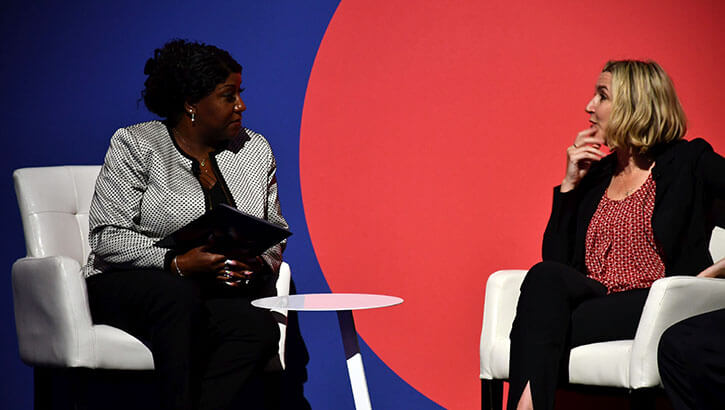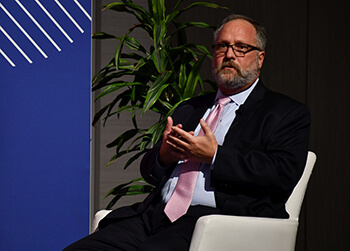Federal leaders highlight electronic health record changes at HIMSS
 Sonja Lemott (left), chief engineer of the Program Executive Office, Defense Healthcare Management Systems (PEO DHMS) interviewed federal leaders, including Holly Joers (right), the program executive officer for PEO DHMS at HIMSS 2021 (Photo by: Jacob Moore, MHS Communications).
Sonja Lemott (left), chief engineer of the Program Executive Office, Defense Healthcare Management Systems (PEO DHMS) interviewed federal leaders, including Holly Joers (right), the program executive officer for PEO DHMS at HIMSS 2021 (Photo by: Jacob Moore, MHS Communications).
"Be the Change" -- this was the overarching theme for the Health Information Management Systems Society (HIMSS) conference held earlier this month.
During the conference, several Defense Department leaders showcased numerous examples of how the federal government serves as a catalyst for change across the healthcare landscape.
Bill Tinston, director of the Federal Electronic Health Record Modernization (FEHRM) program office, equated the evolution of the new single, common record to the evolution of the telephone. "In the past, you called a place - John's house - and asked whether he was there. Now, you call the person on his mobile phone and can reach him wherever he is. The mobile phone removed the limitation of place from the equation. We're doing the same thing with the new single, common record."
The new electronic health record, shared by the Defense Department, Department of Veterans Affairs, and Department of Homeland Security's United States Coast Guard, delivers data to healthcare teams wherever a patient receives treatment. In the past, a patient received care at a specific facility and all records associated with that care resided within that facility. The new shared record makes a patient's records available digitally anywhere a healthcare team or patient needs them.
In 2015, the Program Executive Office, Defense Healthcare Management Systems (PEO DHMS) launched the mission to deliver a new electronic health record to the Military Health System.
 Bill Tinston, director of the Federal Electronic Health Record Modernization (FEHRM) program office responds to audience questions at HIMSS 2021 (Photo by: Jacob Moore, MHS Communications).
Bill Tinston, director of the Federal Electronic Health Record Modernization (FEHRM) program office responds to audience questions at HIMSS 2021 (Photo by: Jacob Moore, MHS Communications).
Holly Joers, the program executive officer for PEO DHMS, noted, "While the new electronic health record is the cornerstone of our digital transformation, our future is tied to the insatiable need for data. In IT, it's easy to focus on systems and their operations, when we should be talking about the data and where it needs to be. People are separated by time and place, but technology bridges those gaps, putting the patient at the center."
Joers also noted that DOD is influencing the private sector through things like the mass vaccination, or MassVax, developed within the new health record. "We had a specific need to vaccinate large numbers of people at a time, so we worked with our vendors to develop MassVax.
In 2020, the private sector had a sudden, unexpected need to manage mass vaccinations. Cerner released our mass vaccination tool to the commercial sector; yet another example of how DOD is driving change."
The new single, common record will ensure that a patient's data follows them from accession through Veteran status. Both Tinston and Joers highlighted joint initiatives between DOD and VA like telehealth services and the joint health information exchange both of which are vital to effective patient care and positive health outcomes.
As Tinston noted, "We know that improved patient care is why we're doing what we're doing right now. But, what's truly exciting is the thought that we don't yet know what unexpected benefits are in store for patients in the future thanks to what we're doing today. That's the change I most look forward to seeing."